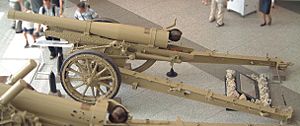Type 96 150 mm howitzer facts for kids
Quick facts for kids Type 96 150 mm Howitzer |
|
|---|---|

Type 96 150 mm Howitzer
|
|
| Type | Howitzer |
| Place of origin | |
| Service history | |
| In service | 1937–1945 |
| Used by | |
| Wars | Second Sino-Japanese War Soviet-Japanese Border Wars World War II |
| Production history | |
| No. built | 440 |
| Specifications | |
| Mass | 4,140 kg (9,130 lb) |
| Barrel length | 3.523 m (11 ft 7 in) |
|
|
|
| Shell | 31.3 kg (69 lb) |
| Caliber | 149.1 mm (5.87 in) |
| Carriage | split trail |
| Elevation | -5 to +65 degrees |
| Traverse | 30° |
| Rate of fire | 3–4 rpm |
| Muzzle velocity | 540 m/s (1,772 ft/s) |
| Maximum firing range | 11,900 m (13,014 yd) |
| Sights | panoramic |
The Type 96 150 mm howitzer was a powerful howitzer (a type of big gun) used by the Imperial Japanese Army. This was Japan's army during World War II. People also called it the "15-cm" gun.
This large artillery (big gun) was made to replace an older model, the Type 4 150 mm howitzer. The Type 96 could fire the same kind of ammunition as the Type 4.
History of the Type 96 Howitzer
The Type 96 howitzer started being built in 1937. In total, 440 of these guns were made.
During the war, a medium artillery group would have 24 Type 96 howitzers.
Where the Type 96 Was Used
The Type 96 15 cm howitzer was used in two major conflicts. It saw action in the Second Sino-Japanese War. It was also used during World War II.
These guns were among the most common artillery weapons used by Japan. Today, one of these Type 96 howitzers is kept at the Yasukuni Shrine in Tokyo, Japan.
Images for kids
See also
 In Spanish: Obús Tipo 96 150 mm para niños
In Spanish: Obús Tipo 96 150 mm para niños


